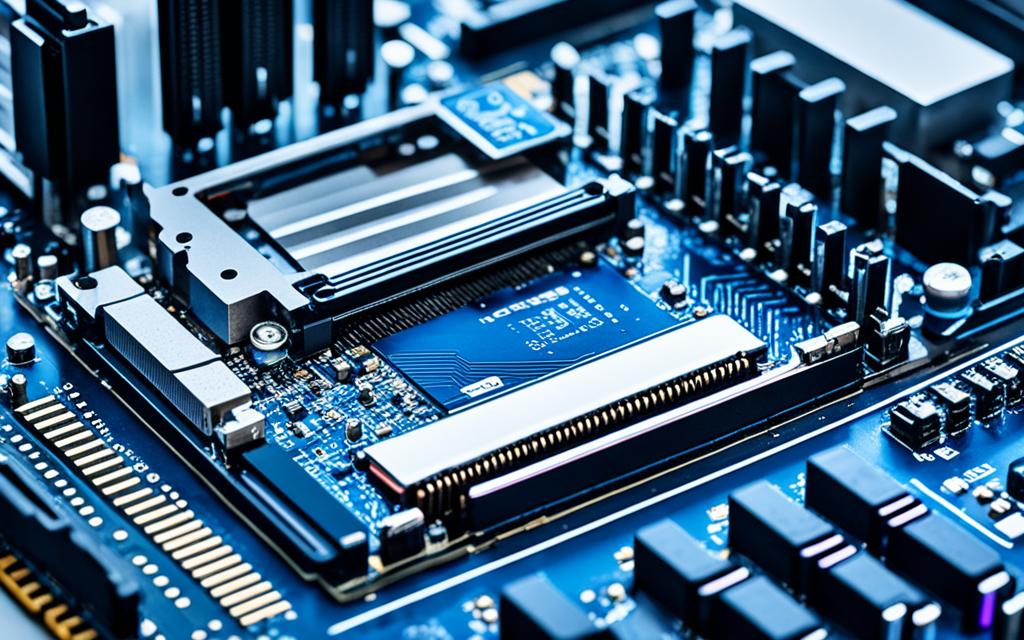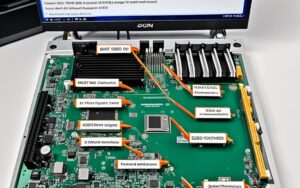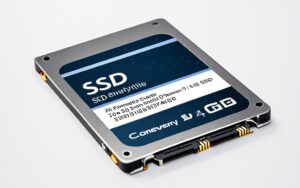Table of Contents
Starting your journey with an SSD upgrade is key for better PC performance. SSDs bring faster data reading and saving, and they’re more power-efficient than old Hard Disk Drives (HDDs). To make sure an SSD fits your PC, you’ll need to know about the connection type, size, and what your PC manual says. It’s not just about getting a new SSD; it’s also about matching it with your PC’s needs. By understanding how SSDs work with different PCs, you won’t waste money on a drive that won’t fit right in. For help on checking if an SSD will work with your system, here’s a great guide to read: SSD compatibility guide1.
Key Takeaways
- Knowing the types of SSD is key to upgrading.
- The right interface is crucial for the best performance.
- Make sure the SSD fits in the drive bay before buying.
- Always check your user manual for the needed specifications.
- Finding the right SSD saves you from expensive errors.
- Technologies like NVMe can make your system run faster.
Introduction to SSD Compatibility
Understanding SSD compatibility basics is key for those who want an upgrade. Many aim to boost their computer’s speed or storage space. This leads to an important question: which SSDs work with my computer? Not every SSD will fit every system due to certain compatibility issues.
SSDs come in two main types: SATA and NVMe. Each type offers different features that affect how they work with your computer. For instance, SATA 2.5-inch SSDs fit into the same slots used by old hard drives. Yet, NVMe M.2 PCIe SSDs are much faster, making them a better option for speed. In fact, NVMe drives can move data up to 25 times faster than SATA ones, with some reaching speeds of 7,300MB/s, like the high-end Kingston’s PCIe 4.0 NVMe SSDs23.
Several things affect SSD compatibility. These include interface types, size, and the specs of your device. For example, NVMe drives can handle many more data queues than SATA drives. This can mean better performance, but only if everything matches up perfectly. Failing to match can cause problems.
Overall, knowing the SSD compatibility basics is vital for upgrading your PC. It’s all about matching the right SSD to your system’s specs.
Understanding SSD Types and Form Factors
Choosing the right SSD for your computer means knowing the different types and forms available. This ensures it fits your device perfectly and boosts performance. By being informed, you pick the best SSD for your needs.
Common SSD Types
2.5-inch SATA SSDs are very popular and work with most computers. These SSDs are designed to easily fit into drive bays, making setup simple. Other common types include mSATA and M.2. mSATA SSDs are much smaller, great for slim devices or added storage in desktops4. M.2 SSDs are tiny, perfect for saving space in small devices. They also support fast connections through PCIe for better performance5.
Form Factors of SSDs
SSD form factors come in styles like 2.5-inch, M.2, mSATA, and U.2. Each has its unique uses and fits. For example, the 2.5-inch SSD is versatile for average users, while M.2 is ideal for speedy tasks like gaming6. Choosing the right SSD type and form is key for a smooth upgrade or build. It ensures compatibility and the best performance for your system5. The way you install these SSDs differs. The 2.5-inch needs SATA cables, but mSATA and M.2 SSDs plug directly into the motherboard4.
How to Know What SSD is Compatible with My PC
Finding the right SSD for your PC can seem tough, but it’s manageable with the right approach. You can both use advanced software that checks SSD compatibility for you7. It scans your system and suggests the best SSDs. A popular choice for this task is the software from Crucial, known for being easy to use and giving correct suggestions7.
Using Software for Compatibility Checks
Using software tools makes picking an SSD easier. These programs figure out if your PC can work with different SSD types and sizes. This way, you avoid mistakes. Software makes sure your choice is precise and you spend less time looking8.
Manual Checking via Motherboard Specifications
If you like to do things yourself, checking your motherboard’s specs is a good step. This tells you which SSD types, like SATA or PCIe, will work. It’s really important for older computers which might not support all SSDs7. Knowing about SSD interfaces and sizes helps a lot for a smooth upgrade.
Checking Your PC’s Specifications
To see if an SSD works with your PC, you need to check several important details. Knowing your PC specifications is key. This helps you understand which drives can be installed. This makes it easier to upgrade or add new ones.
Referencing the User Manual
Your user manual is packed with info. It tells you which drives and interfaces your motherboard supports. It lists drive sizes and types that will work, ensuring you pick the right SSD for your PC. Look at your manual first to avoid choosing the wrong SSD.
Identifying Installed Drive Models
Looking at the installed drives gives you a clear picture of what will work with your PC. Use Windows Device Manager to see the drives you already have. This lets you compare them with the SSDs you’re considering. Knowing your current drive’s specs helps you choose an SSD that fits well with what you’ve got.
Disassembling Your PC to Inspect Ports
If you can’t find the info you need, check the ports by opening up your PC. Taking your PC apart lets you see the connectors and bays for yourself. Just be careful to keep your PC and yourself safe. This way, you’re sure the SSD you choose will fit perfectly.
Common SSD Interfaces and Sizes
It’s essential to know about SSD interfaces and sizes for the right fit with your computer. The popular SSD interface is SATA, with read and write speeds near 500MB per second9. Its 2.5-inch size works well in many desktops and laptops10. M.2 and mSATA are great for those needing high speed in a small size. But, you must check if they match your system’s specs.
SATA Interfaces and Sizes
SATA SSDs are ideal for anyone wanting an easy, value-for-money upgrade. They perfectly fit 2.5-inch drive slots. With a speed of 500MB/s, they’re good for daily tasks9. The price for SATA drives is attractive too. You can find a 10TB drive under $200, though larger SSDs cost more11.
Exploring M.2 and mSATA Options
M.2 drives are gaining fans for their tiny size and top speed. They’re available in many sizes like M.2 Type-2280, going up to 8TB for those needing a lot of space11. They use SATA or PCIe interfaces. High-end models come with NVMe technology for super-fast performance during intense tasks like video editing11.
Understanding NVMe Technology
NVMe tech speeds up data transfers significantly compared to SATA SSDs. NVMe SSDs work 5 to 10 times quicker than SATA ones, marking a big step up in performance9. PCIe Gen4 x4 drives, for instance, reach read and write speeds around 5,000MB per second. This feature is very appealing to pros9
Conclusion
Getting the right SSD for your PC is key to better performance. Start by checking your motherboard’s details and what SSD suits your needs. Picking an SSD with at least 500 MB/s read speed is good for gaming and multitasking. Especially because modern PCs use faster tech like NVMe1213.
M.2 SSDs are also great because they’re small but fast. They fit well in your system without taking much space. If you’re a gamer, consider getting at least 512GB. For big game collections, go for 1TB or 2TB sizes1214.
To install an SSD successfully, make smart choices. Use software checks or your manual to learn about compatibility. This way, you’ll easily move to using SSDs. Making informed decisions is crucial in this process. For more tips on SSD compatibility, click here.
FAQ
What is SSD compatibility?
SSD compatibility means how well a Solid State Drive works with your PC. It looks at things like connection type (SATA or PCIe), size, and the details in the user manual. It’s vital for boosting performance when you upgrade.
How can I determine if an SSD is compatible with my PC?
To check if an SSD will work with your system, you can use software from companies like Crucial. Another way is to look at your motherboard’s specs yourself. This helps you pick the right SSD type.
What are the common types of SSDs?
Common SSDs include the 2.5-inch SATA for desktops, and M.2 and mSATA for laptops. Each design fits different needs. Knowing the differences aids in choosing the right upgrade.
What should I consider when looking at SSD form factors?
When looking at SSD sizes, think about how the drive will fit in your PC. Sizes like 2.5-inch, M.2, and mSATA matter for fit and compatibility.
Can I check my PC’s specifications for SSD compatibility without documentation?
Yes, even without documentation, you can figure out what SSDs will work. You do this by opening up your PC to see the ports and drive spaces. This ensures the new SSD will fit right in.
What are the differences between SATA and PCIe interfaces?
SATA is common and easy to install. PCIe is faster, perfect for those wanting the quickest speed. Knowing this helps pick the best SSD for your needs.
How important is it to check my user manual regarding SSD compatibility?
Your user manual is key for seeing which SSDs will work. It stops you from choosing incompatible drives. This ensures a good upgrade to faster storage.
What role does NVMe technology play in SSDs?
NVMe boosts device speed, offering quicker read and write times than SATA SSDs. It’s important for advanced users to know if their system is NVMe-ready. This affects system performance greatly.
Source Links
- https://www.kingston.com/en/blog/pc-performance/two-types-m2-vs-ssd – 2 Types of M.2 SSDs: SATA and NVMe- Kingston Technology
- https://www.kingston.com/en/ssd/what-is-nvme-ssd-technology – What is NVMe SSD technology? – Kingston Technology
- https://www.crucial.com/articles/about-ssd/what-is-an-ssd – What is an SSD (Solid State Drive)?
- https://www.crucial.in/articles/about-ssd/ssd-form-factors – SSD Form Factors
- https://www.partitionwizard.com/clone-disk/ssd-form-factor.html – How to Pick an SSD of the Right Form Factor for Your Device – MiniTool Partition Wizard
- https://www.simms.co.uk/tech-talk/different-types-of-ssd-form-factors/ – Different Types of Form Factors | Simms International
- https://www.backblaze.com/blog/ssd-upgrade-guide/ – How to Upgrade Your Computer: Migrating from HDD to SDD
- https://www.playstation.com/en-us/support/hardware/ps5-install-m2-ssd/ – How to add an M.2 SSD to a PS5 console (US)
- https://www.pcworld.com/article/394015/what-type-of-ssd-should-you-buy.html – What type of SSD should you buy?
- https://www.crucial.com/support/articles-faq-ssd/common-ssd-specifications – What To Know About Common SSD Specifications
- https://www.tomshardware.com/reviews/ssd-buying-guide,5602.html – How to Buy the Right SSD: A Guide for 2024
- https://www.drmem.com/blog/the-ultimate-guide-to-choosing-the-right-ssd-for-your-gaming-pc/ – The Ultimate Guide to Choosing the Right SSD for Your Gaming PC
- https://www.cclonline.com/article/1892/Guide/Solid-State-Drives-SSDs-/How-to-Choose-the-Right-SSD-for-Your-Computer/ – How to Choose the Right SSD for Your Computer
- https://utopiacomputers.co.uk/blogs/utopia-blogs/revitalise-your-aging-pc-or-laptop-a-comprehensive-guide-to-upgrading-to-an-ssd – Revitalise Your Aging PC or Laptop: A Comprehensive Guide to Upgrading to an SSD









